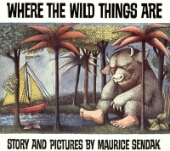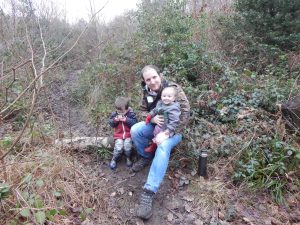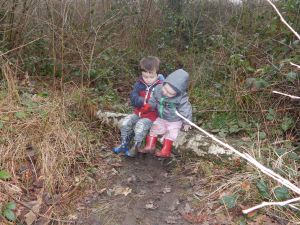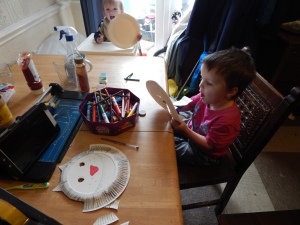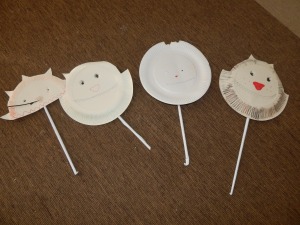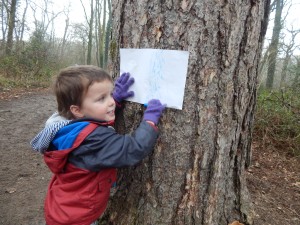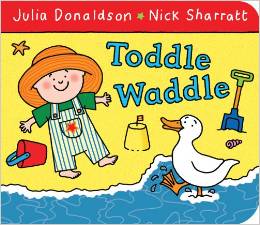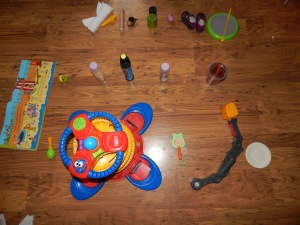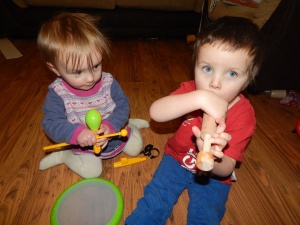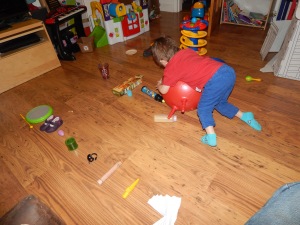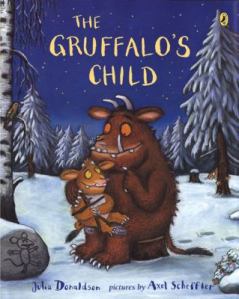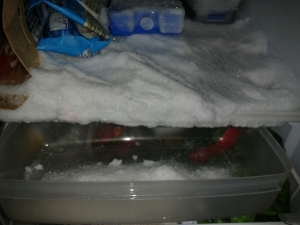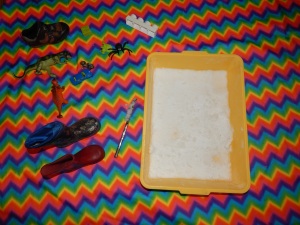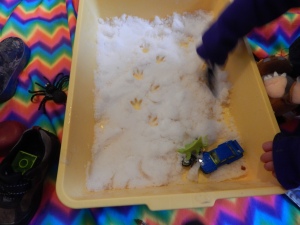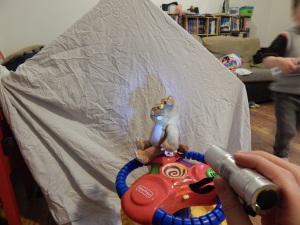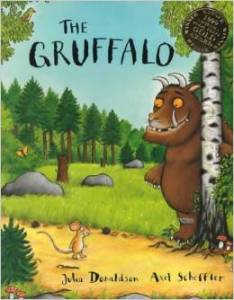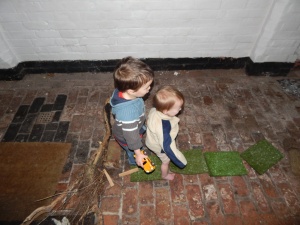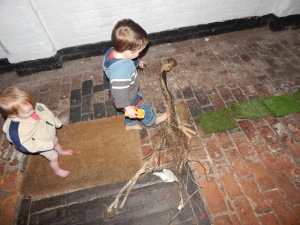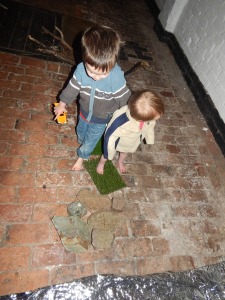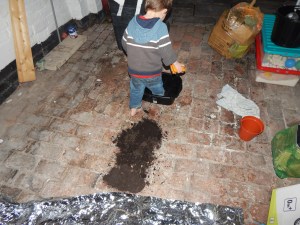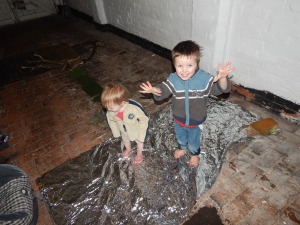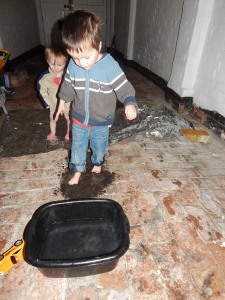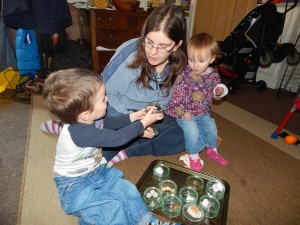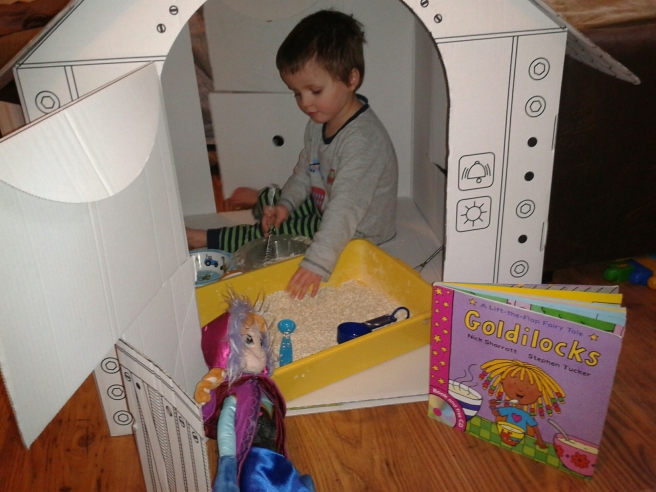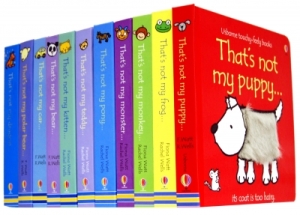 I’ve actually done quite a few activities this week, but haven’t had the time to blog about them, mainly because Bean believes that sleep is over-rated and that if she is going to sleep, she’d like to do so on my face. Tonight, I’ve managed to get her sleeping and actually move away, so I thought I’d try to write up one of the activities. I’m going out of order and doing the one we did today for two reasons. Firstly, that it’s fresh in my mind, and secondly because I love this series. They’re very simple board books with bold, bright illustrations, they all follow the same format: “That’s not my (noun) its (part) is too (adjective).” Each page has a different example of the object or animal featured in that book, with a different textured part, until the end, where we find the correct item. There is a mouse on each page, presumably the items belong to him, a very odd mouse, having his own baby, dinosaur, monkey (though the monkey is an Orangutan, which annoys me as I’m a pedant), goat, rocket etc.
I’ve actually done quite a few activities this week, but haven’t had the time to blog about them, mainly because Bean believes that sleep is over-rated and that if she is going to sleep, she’d like to do so on my face. Tonight, I’ve managed to get her sleeping and actually move away, so I thought I’d try to write up one of the activities. I’m going out of order and doing the one we did today for two reasons. Firstly, that it’s fresh in my mind, and secondly because I love this series. They’re very simple board books with bold, bright illustrations, they all follow the same format: “That’s not my (noun) its (part) is too (adjective).” Each page has a different example of the object or animal featured in that book, with a different textured part, until the end, where we find the correct item. There is a mouse on each page, presumably the items belong to him, a very odd mouse, having his own baby, dinosaur, monkey (though the monkey is an Orangutan, which annoys me as I’m a pedant), goat, rocket etc.
The books help children learn descriptive words, rough, bumpy etc and are good fun. They’re also great for a preschooler to “read” to a toddler or baby.
For today’s activity, I didn’t want to have to do a lot of preparation, or clear up loads of mess. It took me about 5 minutes to set up, which was ideal, and nothing gloopy or messy. The idea was to do our own “That’s not my” game. With various different items for the children to feel, with them trying to figure out which one was the toy rabbit.
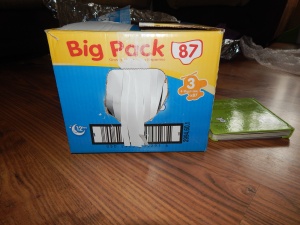 First you need some sort of box to put items into. I used a nappy box as these are sturdy and we happened to have one kicking around. Cut a hole in the front, large enough for you to put your hand inside to feel things (in theory it only needs to be large enough for your child, but it’s likely they’ll want you to try too). You can leave it at that, but I wanted to make sure they couldn’t peep inside, so I fringed some paper and taped it, hanging down inside over the hole. If you had the time it would be nice to cover the box too, but remember to leave the top easy to open, as not all of the items you want to put in will fit through the hole.
First you need some sort of box to put items into. I used a nappy box as these are sturdy and we happened to have one kicking around. Cut a hole in the front, large enough for you to put your hand inside to feel things (in theory it only needs to be large enough for your child, but it’s likely they’ll want you to try too). You can leave it at that, but I wanted to make sure they couldn’t peep inside, so I fringed some paper and taped it, hanging down inside over the hole. If you had the time it would be nice to cover the box too, but remember to leave the top easy to open, as not all of the items you want to put in will fit through the hole.
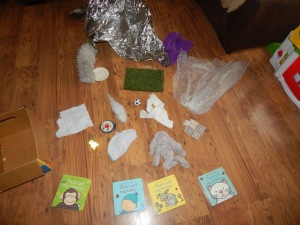 Collect lots of objects and hide them under a sheet. Put one at a time into the box, without children seeing. For older children ask them to feel and describe what they are feeling. Is it their bunny (or whatever toy you picked)? Bean (17 months) doesn’t have many words, so obviously she wasn’t going to describe what she could feel, but mainly just wanted to feel the things and put them in and out, I talked to her about the textures etc as she was feeling them. Jumbles got really into it, trying to work out if each item was the bunny (he was fooled by the feather duster). Then he put things in for me to guess, he decided to play “That’s not my Octonaut” making me work out which of his Octonaut action figures he had put inside.
Collect lots of objects and hide them under a sheet. Put one at a time into the box, without children seeing. For older children ask them to feel and describe what they are feeling. Is it their bunny (or whatever toy you picked)? Bean (17 months) doesn’t have many words, so obviously she wasn’t going to describe what she could feel, but mainly just wanted to feel the things and put them in and out, I talked to her about the textures etc as she was feeling them. Jumbles got really into it, trying to work out if each item was the bunny (he was fooled by the feather duster). Then he put things in for me to guess, he decided to play “That’s not my Octonaut” making me work out which of his Octonaut action figures he had put inside.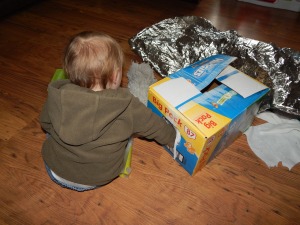
External Links:
Buy “That’s Not My…” books
Borrow “That’s not my…” books

